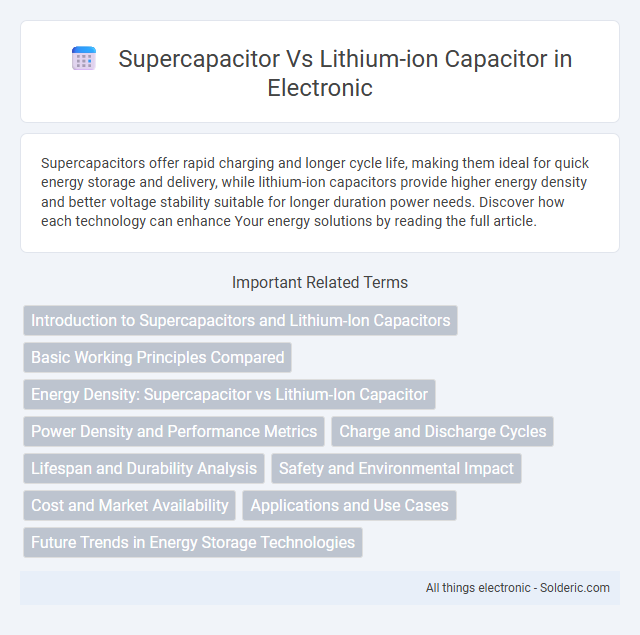Supercapacitors offer rapid charging and longer cycle life, making them ideal for quick energy storage and delivery, while lithium-ion capacitors provide higher energy density and better voltage stability suitable for longer duration power needs. Discover how each technology can enhance Your energy solutions by reading the full article.
Comparison Table
| Feature | Supercapacitor | Lithium-Ion Capacitor |
|---|---|---|
| Energy Density | 5-10 Wh/kg | 20-40 Wh/kg |
| Power Density | Up to 10,000 W/kg | Up to 5,000 W/kg |
| Charge Time | Seconds to minutes | Minutes |
| Cycle Life | Over 1 million cycles | Around 100,000 cycles |
| Operating Voltage | 2.5-3 V per cell | 3.8-4.0 V per cell |
| Self-Discharge Rate | High | Lower than supercapacitors |
| Applications | Power backup, quick charge systems, regenerative braking | Energy storage for hybrid vehicles, power tools, consumer electronics |
Introduction to Supercapacitors and Lithium-Ion Capacitors
Supercapacitors store energy through electrostatic charge accumulation, offering high power density and rapid charge-discharge cycles ideal for applications requiring quick bursts of energy. Lithium-ion capacitors combine the high energy density of lithium-ion batteries with the high power density and long cycle life of supercapacitors, making them suitable for hybrid energy storage solutions. Your choice between the two depends on whether you prioritize energy capacity or power delivery and cycle longevity.
Basic Working Principles Compared
Supercapacitors store energy electrostatically through the formation of an electric double layer at the electrode-electrolyte interface, enabling rapid charge and discharge cycles with high power density. Lithium-ion capacitors combine the electrostatic storage of supercapacitors with the faradaic intercalation mechanism of lithium-ion batteries, using lithium ions to enhance energy density while maintaining faster charging than traditional batteries. The hybrid nature of lithium-ion capacitors results in improved energy retention and higher operating voltages compared to conventional supercapacitors.
Energy Density: Supercapacitor vs Lithium-Ion Capacitor
Supercapacitors offer lower energy density compared to lithium-ion capacitors, typically ranging from 5 to 10 Wh/kg, while lithium-ion capacitors achieve energy densities between 20 to 60 Wh/kg. Your choice depends on whether you prioritize rapid charge-discharge cycles and high power density, favoring supercapacitors, or higher energy storage capacity with moderate power performance, which lithium-ion capacitors provide. These differences make lithium-ion capacitors more suitable for applications requiring both energy density and reasonable power output.
Power Density and Performance Metrics
Supercapacitors offer superior power density compared to lithium-ion capacitors, delivering rapid charge and discharge cycles ideal for high-power applications. Lithium-ion capacitors blend the high energy density of lithium-ion batteries with enhanced power capabilities, providing a balanced performance metric for both energy storage and power delivery. Your choice depends on whether instantaneous power output or a combination of energy capacity and power density is more critical for your application.
Charge and Discharge Cycles
Supercapacitors typically endure over one million charge and discharge cycles, offering exceptional longevity compared to lithium-ion capacitors, which generally sustain around 10,000 to 100,000 cycles. The extensive cycle life of supercapacitors makes them ideal for applications requiring rapid and frequent energy bursts without significant capacity loss. Lithium-ion capacitors balance higher energy density with moderate cycle durability, serving well in scenarios needing a blend of power and energy storage.
Lifespan and Durability Analysis
Supercapacitors offer a significantly longer lifespan, often exceeding one million charge-discharge cycles, compared to lithium-ion capacitors which typically withstand tens of thousands of cycles before capacity degradation. The durability of supercapacitors is enhanced by their ability to operate efficiently across a wider temperature range and resist physical wear due to their solid-state or gel electrolytes. Your choice between these two energy storage devices should consider the specific application demands for longevity and consistent performance under varying environmental conditions.
Safety and Environmental Impact
Supercapacitors offer superior safety due to their non-flammable electrolytes and minimal risk of thermal runaway compared to lithium-ion capacitors, which contain flammable organic electrolytes and pose higher fire hazards. Environmentally, supercapacitors are more eco-friendly because they use abundant, non-toxic materials with longer lifecycles, reducing electronic waste and hazardous chemical disposal. Your choice of supercapacitor enhances sustainability and reduces environmental and safety risks in energy storage applications.
Cost and Market Availability
Supercapacitors generally have a higher initial cost but offer longer cycle life and rapid charge-discharge capabilities compared to lithium-ion capacitors. Lithium-ion capacitors balance cost and energy density, making them more accessible for consumer electronics and automotive markets. Your choice depends on budget constraints and application requirements, with supercapacitors favored in high-power scenarios and lithium-ion capacitors in cost-sensitive, moderate energy demands.
Applications and Use Cases
Supercapacitors excel in applications requiring rapid charge-discharge cycles and high power density, such as regenerative braking in electric vehicles, backup power for memory systems, and grid stabilization for renewable energy sources. Lithium-ion capacitors combine high energy density with good power delivery, making them suitable for hybrid electric vehicles, portable electronics, and energy harvesting devices where longer run-time and moderate power bursts are essential. Industrial uses leverage lithium-ion capacitors for load leveling and peak power support, while supercapacitors dominate scenarios demanding frequent, fast energy pulses.
Future Trends in Energy Storage Technologies
Supercapacitors are evolving with enhanced energy density and faster charge-discharge cycles, making them ideal for applications requiring rapid power delivery and longevity. Lithium-ion capacitors combine battery-like energy density with supercapacitor power performance, positioning them as promising candidates for hybrid energy storage systems. Future trends emphasize integrating nanomaterials and advanced electrolytes to optimize both devices for scalable, high-efficiency energy storage in electric vehicles and renewable grids.
supercapacitor vs lithium-ion capacitor Infographic

 solderic.com
solderic.com